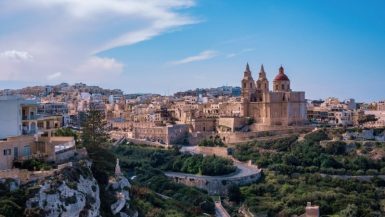
Nordic nations Iceland and Norway are both known for offering spectacular scenery and intoxicating adventures bordering the Arctic Circle. From world-class hiking trails to jaw-dropping fjords and the chance to catch a glimpse of the show-stopping Northern Lights, it can be hard to choose between the two.
Despite their similarities, there are a few key differences between these beautiful countries that might help you decide. Iceland is an island nation, formed 60 million years ago by intense volcanic activity. The island is now a hotbed for geothermal attractions, from steaming springs to bubbling mud pools, active volcanos, and spewing geysers.
Meanwhile, Norway is a much larger Scandinavian country bordering Sweden, encompassing vast mountain ranges, a coastline carved by glacial fjords, and home to nearly 50,000 islands and islets. Here, we compare the two against a range of important criteria such as prices and accommodation, to find out which adventure is right for you.
Iceland or Norway: Getting there

As popular tourism destinations, getting to both Iceland and Norway is easy. Iceland’s main international airport is Keflavík Airport, which is located about 45 minutes by car from the capital city, Reykjavik. You’ll find daily flights from 32 destinations over Europe and beyond, although you may find you need to get a connecting flight if you are coming from further afield. There is also a car ferry to Iceland from Denmark.
In Norway, the main hub for international tourists is Oslo Airport, located just outside the capital. It has direct connections to over 160 destinations worldwide, and there is a 20-minute express train to the city. Meanwhile, the country also has several other international airports, found near popular destinations including Bergen, Kristiansand, Sandefjord, Stavanger, Tromsø, and Trondheim.
Norway borders Sweden, Russia, and Finland, meaning you can arrive by car from any of these countries, with bus services from all three as well as Denmark. An extensive rail network links Norway to the rest of Scandinavia and beyond, with overnight sleeper trains regularly arriving from the continent.
Winner: Norway.
Iceland or Norway: Getting around

Iceland is a relatively small island of around 40,000 square miles, making it possible to pack lots of attractions into one trip. It’s easy and quick to drive or catch a bus between all the major destinations, although winter does bring reduced services and the possibility of difficult road conditions.
Route 1 is a well-sealed coastal road that circles the island via major hotspots such as Reykjavík, Akureyri, Egilsstaðir, and Höfn. Apart from major routes and inside cities, a lot of roads in Iceland are gravel, meaning you may want to consider four-wheel drive if you’re renting a car. Travelers can also get around Iceland by air, with a good-value domestic network linking the capital with several popular places. Due to its small size and spread-out attractions, many visitors to Iceland opt for an organized tour, for which all transport is included.
As a larger country, travel times between destinations in Norway are likely to be longer. However, there are a number of great options. Spacious, high-speed trains operate as far north as Bodø, while there is also an efficient long-distance bus network that usually runs on time.
Driving is possible to the majority of places thanks to some incredible feats of engineering, although be aware many roads are narrow, winding, and not for the faint-hearted. Winter can bring especially challenging conditions. Domestic routes by air are fairly competitive and worth considering if you’re traveling a long distance. With its long and spectacular coastline, one of the best ways to get around Norway is by boat. There are car ferries connecting many islands to the mainland. The Hurtigruten Coastal Ferry travels throughout the day and night, stopping at 35 ports along Norway’s 3,200-mile coastline.
Winner: Iceland.
Iceland or Norway: Attractions

There is plenty to see and do in both Norway and Iceland, particularly for adventure-seekers. Norway is a hiker’s paradise, with breath-taking coastal scenery. It attracts millions each year to marvel at specular rock formations such as Trolltunga, Pulpit’s Rock, Geirangerfjord, and Kjeragbolten.
Nearly all of the best sights are reached on foot, with options for everyone from beginners to highly skilled adventurers. Taking a boat tour or ferry to explore some of the more remote reaches of Norway is also a popular option. The capital Oslo is a colorful, cosmopolitan city with plenty of fascinating museums, including the Viking Ship Museum, featuring vessels from the 9th century, and the Holmenkollen Ski Museum, housed inside a famous ski jump.
Iceland is ideal for nature-lovers, with an abundance of unusual flora and fauna and striking landscapes to explore. Spa-lovers will be in heaven with the choice of natural thermal springs, from the milky waters of the world-famous Blue Lagoon to remote, lesser-known alternatives. You can hike through rainbow-striped lava fields colored by mineral rocks, climb an active volcano, or check out incredible thundering waterfalls such as Skogafoss and Gullfoss.
Iceland is one of the best places in the world to go whale watching, with the opportunity to view several different species including minke, humpback, and orcas. Dolphins are also commonly sighted, while the country’s adorable puffins are always popular with bird-watchers. Other unique activities in Iceland include glacier hiking, exploring ice caves, and checking out the incredible Strokkur Geyser, which erupts every few minutes.
Winner: Iceland
Iceland or Norway: Food

An island nation of immense natural beauty, much of Iceland’s cuisine is inspired by locally grown ingredients. Arctic fish from cod to herring are commonly found on menus, along with seasonally foraged berries, free-range lamb, and even fermented shark, a traditional dish created to help original settlers make it through long, harsh, winters.
Rye bread is another staple, often topped with smoked salmon or other seafood, and every visitor should try skyr, a perfect marriage between yogurt and cottage cheese. Reykjavik has its fair share of fine-dining establishments where you can experience an elegant twist on traditionally humble dishes.
With much of Norway’s landmass located within the Arctic Circle, its cuisine reflects the climate, with lots of hearty, warming, comfort food. Stews are incredibly popular, including some made with sautéed reindeer, while cold-water fish such as cod and salmon are equally commonplace. Pølse is Norway’s answer to a hot dog, consisting of a sausage wrapped in potato pancake and topped with red and yellow sauce.
A burgeoning dining scene means you can easily find Michelin Star restaurants, particularly in Oslo, while the more remote areas are centered around traditional, family-run establishments. Meanwhile, bakeries and street food stalls are sure to satisfy your cravings; don’t miss the Norwegian waffle smothered in jam and cream!
Winner: Norway.
Iceland or Norway: Accommodation

Pretty much everywhere in Norway offers a diverse range of accommodation, from historic lodges located right in the heart of the fjords to boutique city center hotels and even a choice of camping and glamping. Self-catering cottages and cabins are popular with those looking to explore the country’s far-reaching wilderness, while you can now also find upscale mountain lodges if you prefer something a little more five-star.
If you’re hoping to catch a glimpse of the Northern Lights, why not check out the range of incredible igloo-style accommodation, which offers transparent glass domes perfect for stargazing. Winter brings the opportunity to stay in one of several ice hotels, which are constructed from scratch each year with a different design. You’ll also find idyllic farm stays, perfect for those with kids, and sensational treetop cabins, offering a unique take on Arctic romance.
Being smaller, Iceland has fewer choices although there are still options for all tastes and budgets. One of the most luxurious hotels can be found attached to the Blue Lagoon, while there are also one or two more upscale options in Reykjavik and surrounding areas.
A vast majority of the accommodation outside of the capital is made up of lodges, guesthouses, and BnBs, with some more remote locations offering a choice of only one or two. Most rooms are comfortable and hosts are always very welcoming, while some even offer amenities such as hot tubs, restaurants, and bars. You can also peruse a choice of rental cottages, Airbnbs, campsites, and farm stays, with lots of budget-friendly options. The emphasis in Iceland is on the surrounding views, nature, and genial hospitality, complete with charming, rustic details.
Winner: Norway.
Iceland or Norway: Prices

Norway is notoriously expensive, especially when compared with eastern European countries. Food prices can vary a lot depending on where you go and what you order, but an average main course in a mid-range restaurant is likely to set you back around €30 (300 Norwegian Krone), while desert can cost as much as €18 (180 NOK). A beer will likely cost around €8, and you’ll pay around €4 for a soft drink and €3 for a coffee. Tap water is usually free and delicious, coming straight from the glacial fjords.
As an isolated, northern nation, Iceland is also quite expensive. However, prices are not quite as high as in Norway, meaning those on a budget may want to favor this geothermal gem. An average main course in a restaurant will cost about €20 (3000 Icelandic Krona), and washing it down with an imported beer will set you back another €6.60 (1000 ISK). You can grab a cappuccino for around €3 (579 ISK), or a Coca-Cola for around €2.20 (342 ISK). Again, tap water is often free and thought to be some of the cleanest and most delicious drinking water in the world.
Winner: Iceland.
Iceland or Norway: Nightlife

Both Iceland and Norway are adventure destinations, and neither are particularly known for its nightlife. Many people spend long days exploring incredible scenery, meaning a hearty meal and an early night is often the order of the evening. Nevertheless, Oslo does have quite a happening nightlife scene if are staying in the city, with quirky cocktail bars and a handful of clubs.
However, there is one after-dark attraction that lures travelers to Norway from all around the world, and that’s the opportunity to see the incredible Aurelia Borealis or Northern Lights. One of the greatest natural shows on Earth, a clear winter night can bring enchanting patterns of light spiraling through the sky. As mentioned above, there are now even clear-roofed domes where you can watch for the Northern Lights from the comfort of your bed.
It is also possible to see the Northern Lights in Iceland, although sightings are less common. As a rule of thumb, the further north you are, the more likely you will be to spot them. Iceland is not technically located in the Arctic Circle, while much of Norway’s northern reaches are. Despite its small size, Reykjavik has a vibrant nightlife scene, with parties often raging on until the early hours, and several colorful festivals and events regularly taking place.
Winner: Norway.
Iceland or Norway: Conclusion
It’s clear that both Iceland and Norway offer a once-in-a-lifetime experience, particularly for those who love wild, remote adventures.
Which you choose will depend on what kind of adventure you’re looking for. If you love staying active from dawn till dusk, long treks through unspoiled scenery, and don’t mind paying an extra euro or two for tasty food and drink, then Norway should be your choice.
If you’re on a tighter budget, Iceland is a great option. It offers more unique adventures fuelled by geothermal activity, while you’ll also get the chance to rest your weary legs in rejuvenating hot springs. Those hoping to spot the Northern Lights should always choose Norway, while wildlife-lovers are better catered to in Iceland.


